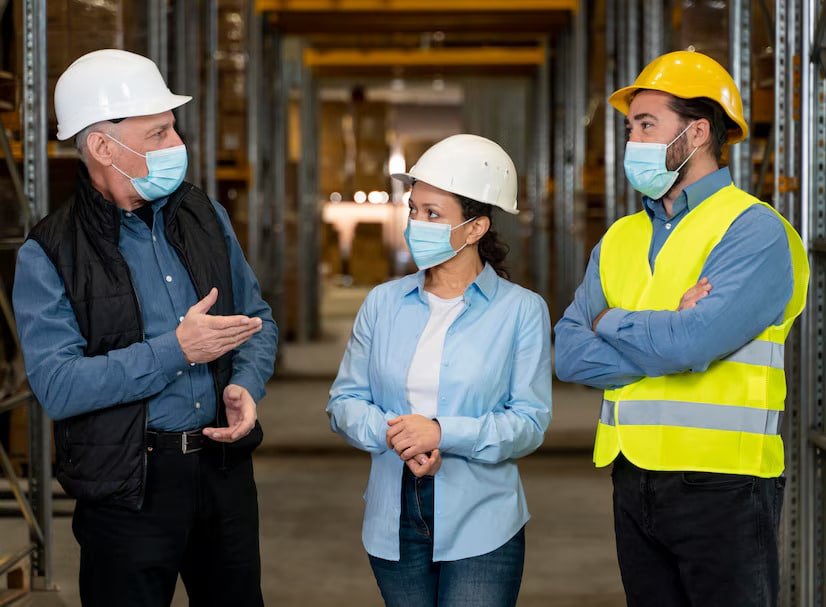Insurance plays a vital role in providing financial protection for individuals and businesses. From homeowners insurance to safety auto insurance, insurance coverage offers peace of mind and mitigates potential risks. Understanding the benefits of safety insurance is crucial for individuals and businesses alike.
Key Takeaways:
- Safety insurance provides financial protection for individuals and businesses.
- Homeowners insurance and safety auto insurance are essential coverage options.
- Insurance companies offer discounts and competitive rates.
- Insurance helps manage cash flow uncertainty and complies with legal requirements.
- Safety insurance supports risk control activities and reduces social burden.
The Importance of Safety in and Around Your Home
Promoting safety in and around the home is crucial. By implementing proper safety measures, homeowners can mitigate the risk of accidents and protect their property and loved ones. Here are some important safety considerations for homeowners:
- Keep areas clutter-free: Cluttered spaces can increase the risk of accidents and injuries. Make sure to keep walkways and staircases clear of clutter and obstacles.
- Secure furniture and supplies: To prevent accidents, it’s important to secure heavy furniture and supplies that could potentially topple over. Use brackets and straps to anchor furniture to the walls and ensure that heavy items are stored securely.
- Prepare for extreme weather events: Homeowners should take necessary precautions to prepare their homes for extreme weather conditions like hurricanes, storms, and floods. This includes reinforcing windows and doors, securing outdoor furniture, and trimming overhanging tree branches.
- Protect against intrusions and cyber threats: Homeowners should invest in reliable security systems and take precautions to safeguard their homes from intrusions. Additionally, it’s essential to protect against cyber threats by using secure Wi-Fi networks and practicing safe online habits.
When it comes to protecting your home and belongings, having reliable home insurance is crucial. Safety Insurance offers comprehensive homeowners insurance policies that provide coverage for losses to the home and its contents. In addition to property protection, their policies also include liability coverage, shielding homeowners from unforeseen accidents and incidents that could result in legal claims.
“Safety Insurance is committed to protecting homeowners and their properties. We offer enhanced coverage options tailored to individual needs, ensuring our policyholders have peace of mind knowing their homes are safeguarded.”
Furthermore, Safety Insurance offers competitive rates, including discounts for homeowners who have implemented safety measures and are loss-free. By taking proactive steps to protect your home and bundling your home insurance with auto insurance coverage, you can qualify for additional discounts.
Understanding Home Insurance Coverage

Home insurance coverage provides essential protection for homeowners against a wide range of potential risks and damages. It safeguards not only the physical structures on the property but also the belongings inside, providing peace of mind and financial security.
Comprehensive Coverage for the Dwelling and Other Structures
Home insurance coverage encompasses the dwelling itself, ensuring that in the event of covered perils, such as fire, theft, or vandalism, repairs or rebuilding costs are taken care of. This coverage extends to other structures on the property, such as garages or sheds, offering comprehensive protection.
Protection for Personal Belongings
Home insurance also includes coverage for personal belongings within the insured dwelling. This ensures that items like furniture, appliances, electronics, and clothing are protected in case of damage or theft. The coverage typically extends beyond the boundaries of the property, providing coverage for personal belongings even when they are outside the home.
Liability Coverage for Added Security
In addition to property protection, home insurance offers liability coverage. This coverage safeguards homeowners against third-party claims for bodily injury or property damage that may occur on their property. It provides financial protection and legal assistance in case of lawsuits arising from covered incidents.
“Home insurance coverage provides peace of mind and financial security for homeowners.” – John Smith, Insurance Expert
Optional Endorsements for Enhanced Protection
Home insurance policies often offer optional endorsements to enhance the coverage provided. One such endorsement is Home Cyber Protection, which protects against losses related to cyber threats. With the increasing prevalence of online fraud and data breaches, this additional coverage can provide homeowners with valuable protection against cyber-related losses.
| Home Insurance Coverage | Typical Inclusions |
|---|---|
| Dwelling | Protection for the physical structure of the home |
| Other Structures | Coverage for garages, sheds, and other structures on the property |
| Contents | Insurance for personal belongings inside the home |
| Liability | Financial protection against third-party claims |
| Cyber Protection (Optional) | Enhanced coverage against cyber-related losses |
Home insurance coverage offers a comprehensive range of protections for homeowners, ensuring that they are safeguarded against various risks and damages. From protecting the physical structures and personal belongings to providing liability coverage and optional endorsements like Home Cyber Protection, home insurance plays a crucial role in keeping homeowners financially secure.
Creating a Comprehensive Safety Program

Creating a **safety program** is a crucial step in ensuring a secure and healthy work environment. It requires **management commitment** and **worker involvement** to successfully implement and maintain safety protocols.
Communication and Involvement
To establish an effective safety program, **management commitment** is essential. Leaders should clearly communicate the importance of workplace safety and involve workers in the program’s formation and implementation. This fosters a culture of safety throughout the organization.
Worksite Analysis
A **worksite analysis** is a critical component of a comprehensive safety program. It involves identifying and assessing workplace hazards to develop appropriate preventive measures. External entities may be involved, such as safety experts or regulatory agencies, to ensure thorough analysis.
Hazard Prevention and Control
Effective **hazard prevention** and **control** measures must be established and enforced. This includes implementing safety policies, providing necessary safety equipment, and regularly inspecting the premises for potential hazards. Ongoing monitoring and evaluation ensure continuous improvement in safety practices.
Training
Proper **training** is crucial for all employees to ensure they understand safety protocols and how to mitigate risks. Training should be provided to workers at all levels, including supervisors and managers, enabling them to reinforce safety measures and lead by example.
By creating a comprehensive safety program that prioritizes **management commitment**, **worker involvement**, **worksite analysis**, **hazard prevention**, **control**, and **training**, organizations can cultivate a safer and healthier work environment. This proactive approach to safety not only protects employees but also helps businesses mitigate risks and prevent accidents.
Developing Effective Safety Rules and Regulations

Safety rules are the foundation of any successful safety program. They provide guidelines and expectations for employees to follow, ensuring a safe and secure work environment. To develop effective safety rules and regulations, organizations should take a proactive and collaborative approach.
One crucial step in creating safety rules is to involve a diverse group of individuals, such as a safety committee, in the process. This collaborative effort helps bring together different perspectives and ensures that the rules are comprehensive and relevant to the specific work environment. By collectively developing the safety rules, employees feel more engaged and invested in their implementation.
The development of safety rules should be based on a thorough understanding of source documents and regulatory requirements. These documents serve as valuable resources in identifying potential hazards and outlining best practices. By aligning safety rules with established guidelines, organizations can ensure compliance and enhance overall safety.
Enforcement plays a vital role in the effectiveness of safety rules. All employees should receive copies of the safety rules and be aware of them. Supervisors play a critical role in enforcing these rules by actively monitoring and addressing any violations. Through consistent enforcement, organizations demonstrate their commitment to safety and create a culture of accountability.
Safety committees are instrumental in promoting safety within the organization and supporting the success of the safety program. Composed of knowledgeable members with diverse backgrounds, safety committees act as advocates for safety and help identify and address potential hazards. They play a vital role in creating a culture of safety and ensuring that safety rules and regulations are effectively implemented throughout the organization.
The Role of Supervisors and Safety Committees
Supervisors play a crucial role in enforcing safety rules and regulations. As leaders, they are responsible for setting a positive example and ensuring that employees understand the importance of compliance. Supervisors should actively communicate safety expectations, provide necessary training, and address any safety concerns promptly.
Safety committees, on the other hand, serve as a valuable resource for employees and management alike. They actively participate in the identification and resolution of safety issues, conduct safety audits, and provide recommendations for improvement. Safety committees foster a sense of collaboration and engagement, making them key drivers of a successful safety program.
The Benefits of Effective Safety Rules and Regulations
Having effective safety rules and regulations brings numerous benefits to organizations. It helps reduce the risk of accidents, injuries, and occupational hazards, resulting in increased productivity and decreased downtime. Compliance with safety rules mitigates potential legal and financial repercussions, protecting the organization’s reputation and bottom line.
By creating a safe work environment through well-defined safety rules and regulations, organizations demonstrate their commitment to employee well-being. This promotes a positive workplace culture, boosts employee morale, and improves overall job satisfaction. It also attracts top talent and reduces turnover rates, as employees are more likely to choose employers that prioritize their safety.
| Benefits of Effective Safety Rules and Regulations | |
|---|---|
| 1. | Reduced risk of accidents, injuries, and occupational hazards |
| 2. | Increased productivity and decreased downtime |
| 3. | Protection against legal and financial repercussions |
| 4. | Promotion of a positive workplace culture |
| 5. | Boost in employee morale and job satisfaction |
| 6. | Attracting top talent and reducing turnover rates |
The Benefits of Safety Committees

Safety committees play a crucial role in supporting an organization’s loss control program. They not only help maintain employee interest and involvement in safety efforts but also promote a culture of safety within the workplace. By actively engaging employees in safety measures, including front-line workers, safety committees contribute to creating a safer and healthier work environment.
One of the key benefits of safety committees is their ability to monitor safety efforts. These committees are responsible for regularly assessing the effectiveness of existing safety protocols and identifying areas for improvement. By conducting thorough evaluations, safety committees ensure that the organization remains proactive in its approach to safety.
The educational aspect of safety committees is equally important. Committees are responsible for educating employees about safety procedures, best practices, and potential hazards. Regular safety trainings and workshops organized by these committees help raise awareness and ensure that all employees have the necessary knowledge to maintain a safe work environment.
In the event of accidents or near misses, safety committees play a crucial role in investigating incidents and implementing corrective actions. By thoroughly analyzing the causes of accidents, safety committees can identify underlying issues and develop strategies to prevent similar incidents in the future. This proactive approach significantly contributes to loss control within the organization.
Evaluating safety efforts is an integral part of the responsibilities of safety committees. By regularly evaluating the effectiveness of safety measures and programs, these committees ensure that the organization’s safety initiatives align with its goals. Through comprehensive evaluations, safety committees can make informed recommendations for improvement and help maintain a strong safety culture.
Management Support
The success of safety committees is heavily reliant on the support they receive from top-level management. Management support is essential in providing resources, time, and financial backing for the implementation of safety measures and initiatives. When management actively encourages employee involvement in safety committees and recognizes their contributions, it fosters a sense of ownership and accountability among employees.
Furthermore, management support is critical in incorporating safety committees’ recommendations into the organization’s overall safety strategies. By embracing the input and insights of safety committees, management can effectively address operational risks, improve safety policies, and enhance loss control efforts.
All in all, safety committees serve as a driving force for employee involvement and loss control. Their responsibilities extend beyond monitoring and evaluation to include education, investigation, and overall safety program development. With management support and active employee participation, safety committees can significantly contribute to creating safer work environments and reducing risks within organizations.
| Benefits of Safety Committees | |
|---|---|
| Engages employees in safety efforts | Employee involvement |
| Monitors and evaluates safety efforts | Loss control |
| Educates employees about safety procedures | Employee involvement |
| Investigates accidents and implements corrective actions | Loss control |
| Evaluates the effectiveness of safety measures | Loss control |
| Relies on management support for resources and implementation | Management support |
Implementing Safety and Health Programs
Implementing effective safety and health programs is crucial in reducing the risk of workplace injuries and illnesses. These programs promote a safe and healthy work environment, ensuring the well-being of employees and enhancing overall productivity.
When employees feel safe and engaged in the safety program, their job satisfaction increases, leading to higher morale and better performance. By prioritizing injury prevention and employee engagement, employers can create a positive and conducive work culture.
A well-designed safety program involves comprehensive training at all levels, ensuring that employees have the knowledge and skills to identify and prevent potential hazards. Regular training sessions should be conducted to keep employees updated on safety protocols and procedures.
In addition to training, implementing safety and health programs can also lead to cost savings for employers. By reducing the number of workplace injuries, employers can minimize recruitment and training expenses associated with replacing injured workers. This not only saves money but also helps maintain a stable workforce.
Leadership’s commitment to safety is vital for the success of these programs. When management actively supports and encourages employee participation, it creates a culture of safety and demonstrates its importance within the organization. Regular communication from management about safety performance and initiatives fosters a sense of responsibility among employees.
Ultimately, implementing safety and health programs requires a multi-faceted approach that involves strong leadership, active employee involvement, and ongoing training. By prioritizing safety, employers can create a secure work environment, protect their employees from harm, and reap the benefits of a productive and engaged workforce.
The Importance of Safety Insurance for Businesses

Safety insurance is a critical aspect of protecting businesses and mitigating risks. It provides essential coverage and ensures that business owners are financially prepared for unforeseen events. Safety insurance encompasses various types of coverage, including commercial auto insurance, liability coverage, and comprehensive business insurance.
One vital area of safety insurance for businesses is commercial auto insurance. This type of coverage protects business-owned vehicles and fleets against potential accidents, damages, and other related liabilities. Whether it’s delivery vans, company cars, or service vehicles, commercial auto insurance offers the necessary financial protection to handle any unforeseen situations on the road.
Another crucial component of safety insurance for businesses is liability coverage. Accidents or property damage can occur at any time, potentially leading to expensive legal claims and settlements. Liability coverage ensures that businesses are protected in such situations, covering the costs associated with bodily injury, property damage, and legal expenses.
In addition to commercial auto and liability coverage, comprehensive business insurance is essential for safeguarding a business’s assets. Comprehensive business insurance provides coverage for property damage, theft, business interruption, and other risks specific to the industry. This comprehensive coverage package offers peace of mind, allowing business owners to focus on their core operations without worrying about potential financial losses.
The Benefits of Safety Insurance for Businesses:
- Protects business-owned vehicles and fleets
- Covers potential accidents, damages, and liabilities
- Safeguards against legal claims and settlements
- Provides coverage for property damage, theft, and business interruption
- Offers peace of mind and financial security
Safety insurance not only provides coverage but also plays a vital role in risk management. By implementing effective risk management strategies, businesses can identify potential risks, evaluate their impact, and take proactive measures to minimize or eliminate them. Safety insurance acts as a safety net, ensuring that businesses can weather unexpected situations and continue operating smoothly.
In summary, safety insurance is of utmost importance to businesses. It offers coverage for commercial auto fleets, liability protection, and comprehensive business insurance. By managing risks and having adequate insurance coverage, businesses can protect their assets, safeguard their financial stability, and operate with confidence.
The Range of Safety Insurance Offerings

Safety Insurance offers a wide range of coverage options to meet the diverse needs of individuals and businesses. With a strong focus on customer satisfaction and financial strength, Safety Insurance is a trusted provider in the industry.
Homeowners Insurance
For homeowners, Safety Insurance offers comprehensive coverage options to protect their most valuable asset. From dwelling coverage to personal property protection and liability coverage, homeowners can customize their policies to suit their specific needs. Safety Insurance also provides coverage for additional threats, such as cyber protection, ensuring homeowners are safeguarded in an increasingly digital world.
Auto Insurance
When it comes to auto insurance, Safety Insurance has you covered. They offer a range of coverage options for both personal and commercial vehicles, providing financial protection in the event of accidents, theft, or property damage. With Safety Insurance, drivers can have peace of mind knowing that they are protected on the road.
Business Insurance
Business owners can rely on Safety Insurance for comprehensive coverage options tailored to their specific industries. From commercial auto insurance to general liability coverage, Safety Insurance helps protect businesses from potential risks and liabilities. Their offerings also include risk management strategies to help businesses mitigate and minimize potential dangers.
Discounts and Customer Satisfaction
Safety Insurance understands the importance of affordability and customer satisfaction. That’s why they offer a variety of discounts to ensure policyholders receive the best value for their coverage. Discounts are available for bundling policies, maintaining a loss-free record, and insuring both home and auto with Safety Insurance.
Financial Strength
Financial stability is a crucial factor when choosing an insurance provider. Safety Insurance has a strong financial foundation, ensuring that they are well-equipped to handle claims and provide support to policyholders when needed. With Safety Insurance, customers can have confidence in their coverage and peace of mind knowing that their insurance needs are in capable hands.
| Coverage Options | Discounts | Customer Satisfaction | Financial Strength |
|---|---|---|---|
| Homeowners Insurance | Discounts for bundling policies | Focus on customer satisfaction | Strong financial foundation |
| Auto Insurance | Loss-free record discounts | ||
| Business Insurance | Discounts for insuring both home and auto |
Safety Auto Insurance Reviews
Safety Auto Insurance receives consistently positive reviews from customers for its reliable coverage and excellent customer service. Policyholders appreciate the ease of filing claims and the prompt resolution of issues. Many commend Safety Auto Insurance for its competitive rates and customizable coverage options tailored to individual needs. Additionally, the company’s commitment to safety initiatives and accident prevention programs earns praise from drivers concerned about road safety. Overall, Safety Auto Insurance stands out as a trustworthy choice for those seeking dependable auto insurance coverage.
Safety Insurance Pricing and Discounts
Safety Insurance offers competitive pricing and a variety of discounts to help customers save on their insurance premiums. By bundling multiple policies such as auto and home insurance, policyholders can enjoy significant savings. Additionally, Safety Insurance offers discounts for safe driving records, anti-theft devices, and advanced safety features in vehicles. Students and young drivers may also qualify for discounts based on academic achievement or completion of driver education courses. With a range of discounts available, Safety Insurance strives to make comprehensive coverage more affordable for individuals and families while rewarding responsible behavior on the road.
Other home insurance companies to consider
When considering home insurance options, it’s essential to explore other reputable companies besides Safety Insurance. Companies like Allstate, State Farm, and Progressive offer comprehensive coverage tailored to individual needs. Additionally, Liberty Mutual and USAA provide excellent customer service and competitive rates. Those seeking specialized coverage might consider companies like Lemonade, which offers digital-first policies with transparent pricing. Travelers Insurance and Nationwide are also worth considering for their flexible coverage options and strong financial stability. Ultimately, researching and comparing quotes from multiple insurers ensures finding the best coverage and value for your home insurance needs.
Safety insurance review: Summary
Summarizing Safety Insurance reviews reveals a consistently positive sentiment among customers. They applaud the company for its reliable coverage, competitive pricing, and excellent customer service. Policyholders appreciate the ease of filing claims and the prompt resolution of issues, as well as Safety Insurance’s commitment to safety initiatives. While some may have encountered occasional challenges, overall satisfaction remains high. Safety Insurance stands out as a trustworthy choice for individuals and businesses seeking dependable coverage and personalized service. With its strong reputation and customer-focused approach, Safety Insurance continues to earn praise from satisfied policyholders.
Also Read: General Insurance: Secure Your Future with Ease
Conclusion
Safety Insurance offers a wide range of benefits for individuals and businesses seeking financial protection and risk management solutions. With their comprehensive coverage options, including home insurance and business insurance, they provide peace of mind and secure valuable assets. Whether safeguarding homes and belongings or managing risks in a business setting, Safety Insurance is a trusted choice.
The extensive coverage options provided by Safety Insurance ensure that individuals are protected from unforeseen events. Home insurance coverage offers financial security for damages to the dwelling, contents, and liability. Business insurance provides comprehensive coverage, including liability and commercial auto fleets. With Safety Insurance, individuals and businesses have the necessary coverage to safely navigate life’s uncertainties.
In addition to their coverage options, Safety Insurance offers discounts and supports risk management strategies. This commitment to risk management ensures that individuals and businesses can effectively manage potential risks. Safety Insurance prioritizes customer satisfaction and offers reliable financial strength, making them a top choice for those seeking safety insurance. Ultimately, Safety Insurance provides the benefits, coverage, and peace of mind that individuals and businesses need.
FAQs
Q: What is Safety Insurance and how can it benefit individuals and businesses?
A: Safety Insurance is a company that offers various types of insurance coverage, including auto, home, and business insurance. Individuals and businesses can benefit from Safety Insurance by obtaining coverage to protect themselves and their assets from unforeseen events such as accidents, natural disasters, or theft.
Q: How can I find information about Safety Insurance rates and coverage options?
A: You can visit the Safety Insurance website or contact an independent agent to inquire about their insurance rates and coverage options. Additionally, you may also use their mobile app to access information about rates and coverage.
Q: What are the pros of choosing Safety Insurance as my insurance provider?
A: Some advantages of choosing Safety Insurance include their wide range of coverage options, competitive rates, and convenient mobile app for managing your policies. They also offer benefits such as guaranteed replacement cost, pet coverage, and rental car coverage.
Q: What are some cons of Safety Insurance that individuals and businesses should be aware of?
A: While Safety Insurance offers many benefits, some potential drawbacks to consider include higher than average insurance costs, limited state availability, and specific coverage exclusions. It is advisable to review these factors before choosing Safety Insurance.
Q: How can I get a quote for insurance coverage from Safety Insurance?
A: You can obtain a quote from Safety Insurance by visiting their website, contacting an independent agent, or using their mobile app. By providing necessary information about your insurance needs, you can receive a personalized quote for coverage.
Q: What types of insurance coverage does Safety Insurance offer?
A: Safety Insurance provides a variety of coverage options including auto, home, business, umbrella, and rental insurance. They also offer additional coverage such as pet coverage, guaranteed replacement cost, and rental car coverage for their policyholders.
Q: When was Safety Insurance founded and what is their state availability?
A: Safety Insurance was founded in 1979 and is available in select states across the U.S., with a focus on New Hampshire and Maine. It is recommended to check their website or contact an agent to confirm availability in your specific location.
